

Ecommerce has significantly changed the retail landscape, facilitating round-the-clock shopping irrespective of geographical limitations.
An integral part of this online shopping experience is its visual appeal, with product photography playing a central role in its success.
Product photographs act as a silent salesperson, efficiently communicating critical product details. They replicate the tactile experience of traditional brick-and-mortar stores, significantly influencing consumers’ buying behavior.
Essentially, high-quality and accurate product photography spurs ecommerce growth by giving customers the confidence to make purchase decisions.
So in this guide, we will walk you through what product photography is, how to get it done, the difference between professional vs DIY product photography, and how proper product photographs can help you boost your conversions and sales.
How Can Product Photography Increase Conversions and Sales?
Product photography can significantly increase conversions and sales in Ecommerce by playing a pivotal role in ensuring customer engagement, trust, and purchasing decisions.
1. Builds Purchase Confidence
High-quality, detailed photographs allow shoppers to examine the product closely, which can help build confidence in their purchase decisions. According to a survey, up to 90% of online buyers consider photo quality critical when making a purchase.
2. Improves Product Understanding
Accurate photographs showcasing various views and details of the product can provide a comprehensive understanding.

Providing close-ups, 360-degree views, or images of the product in use can significantly improve the customer’s product understanding, affecting conversion positively.
3. Reduces Product Returns
Quality photographs lessen the gap between online product representation and the actual product. Good images show buyers exactly what they will receive, reducing the likelihood of returns stemming from unmet expectations.
4. Enhances Brand Trust
Consistent, professional product photography can go a long way in building brand trust. According to a report, around 46.1% of web users consider the website’s design, including photos, a criterion for assessing company credibility.
5. Boosts Engagement
Interesting, appealing product photography captures the customer’s attention, making them linger longer on the product pages on your site, leading to improved chances of purchase. The addition of interactive images like 3D or AR can further enhance engagement.
6. Establishes Emotional Connection
Good product images often tap into the emotional quotient of the buyer too. For instance, lifestyle photos or images showing the product in use can help potential buyers visualize and connect emotionally to owning the product, which can prompt purchase decisions.
So investing in quality product photography can pay massive dividends in the form of higher customer engagement, trust, conversion rates, sales, and lower returns. As an ecommerce business, you must leverage it to stand out in today’s competitive digital marketplace. Now let’s start with the basics of product photography and its different types.
Understanding Product Photography
Product Photography is a branch of commercial photography that concentrates on presenting a product as appealingly and accurately as possible. The goal is simple: to attract potential customers to your webpage and convert them into long-term clients.
The artistry in product photography lies in the details. Lighting, for instance, is pivotal to creating a mood and showcasing the product features. Natural light works well for products displayed in real-world settings, while studio light can provide artificial light with greater control for highlighting product details.

Background selection is another key aspect. The goal is to make the product stand out. White and neutral backgrounds are popular due to their knack for highlighting the product, while creative, context-driven backgrounds can provide a unique vibe and help customers visualize the product in their lives.
No less important is the image and taking high-quality photos. High-resolution images reveal intricate details and allow zoom-in functionality. Always ensure that images are sharp, well-balanced, and free from noise. Remember, a good product photograph is often the difference between cart abandonment and a completed purchase.
The Types of Product Photography
Product photography is not one-size-fits-all. Different types of product photography can be employed depending on the product and brand image.
Studio Product Photography involves shooting products in a controlled environment with the assistance of professional lighting, backgrounds, and photography gear. This allows for high-quality, detailed, distraction-free images that put the product front and center.
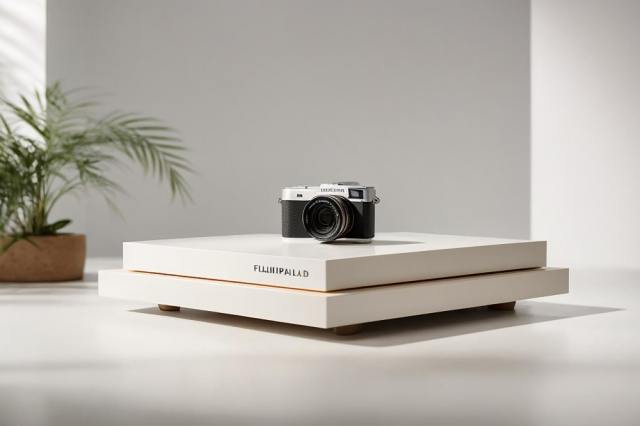
Lifestyle Product Photography displays the product in its natural or intended use environment, blending it into everyday life. This provides context for product shots and aids the customer in visualizing the product in use. For example, a coffee mug might be shot on a kitchen counter surrounded by a newspaper and a plate of cookies.

Group Photos showcase multiple complementary products together. They are a great option for promoting multiple items together and are particularly useful in providing a comparative overview of products available in different shades, sizes, or styles.
Lastly, Experimental or Creative Product Photography ideas use unconventional techniques like exciting play of shadows, unique props, dramatic lighting, or extreme close-ups to create eye-catching images that beckon the viewer.

Each type has unique advantages and application: choose what best fits your requirements and resonates with your brand vision. After all, it’s not just about capturing a product; it’s about narrating its story visually compellingly that piques customer curiosity and propels growth in the Ecommerce ecosystem.
The Role of Product Photography in Ecommerce
Product photography has a profound impact on how customers perceive a product. On an Ecommerce portal where physical interaction is absent, customers rely heavily on the images to evaluate a product.
High-quality photography makes a difference, exuding a sense of professionalism and reliability that shapes the customer’s perception of the product and the brand.
Product photography also has an undeniable influence on purchasing decisions. Customers in an Ecommerce platform cannot physically touch, feel, or try the products. Hence they rely heavily on product images to make buying decisions.

It is a well-crafted image that accurately depicts the product features, design, color, and size. It can even simulate the in-store experience, making the customer confident about the purchase.
Furthermore, product photography is crucial in establishing a brand’s identity in the digital universe. Your product images’ style, quality, and presentation speak volumes about your brand and what it represents.
They constitute an integral part of the overall brand aesthetics and align with the brand narrative, design, and color scheme to create a cohesive visual story that resonates with the targeted audience and sets the brand apart in the competitive Ecommerce arena.
Case Studies and Examples
Nailing product photography can propel your brand to coveted consumer preference and loyalty. The following case studies show how businesses leverage product photography to capture customer attention and drive growth.
1. Ecommerce giants like Amazon
Amazon, the world’s largest online retailer, highly emphasizes product photography. Every product listed on Amazon must have high-resolution images, with the product occupying at least 85% of the frame.
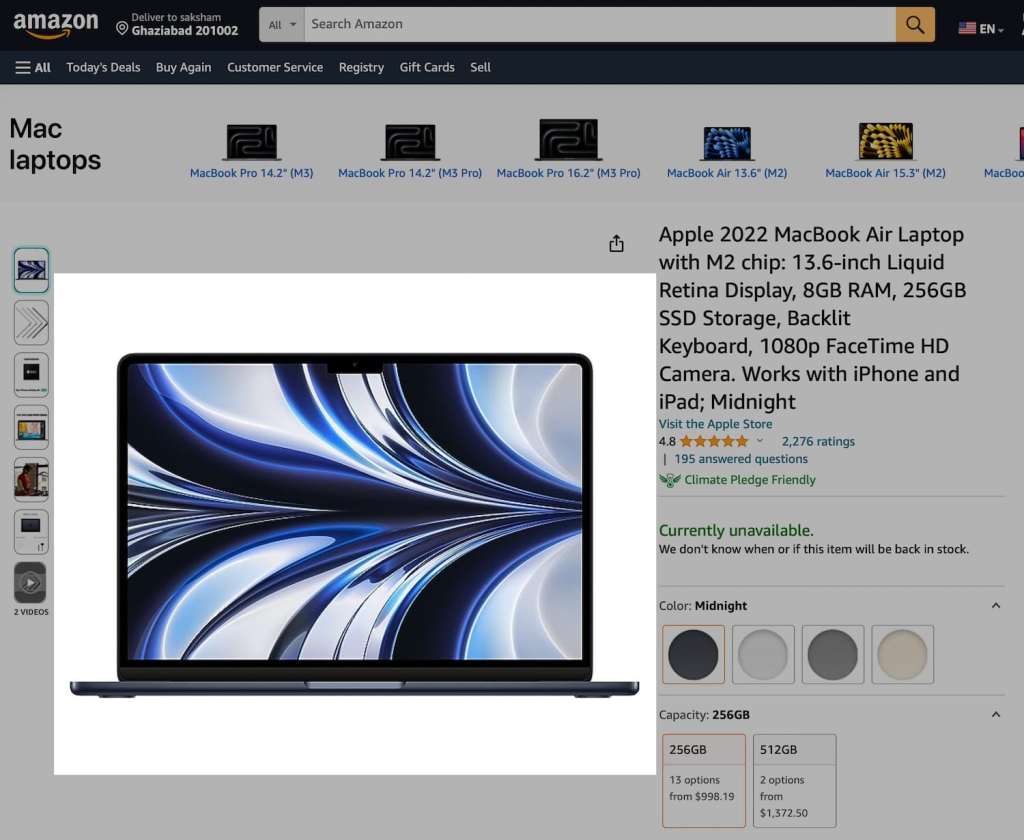
This focus on clear and professional product photography has played a significant part in establishing Amazon’s reputation as a trusted destination for online shopping.
2. A fashion-focused Ecommerce business
ASOS, an online fashion and cosmetic retailer, sets an excellent example with its distinctive approach to product photography.
It provides multiple photos from different angles, detailed zoom-in options, and even catwalk videos. This comprehensive visual representation emphasizes the product details. It gives a clear idea of how the product looks in use, allowing customers to make an informed choice, thereby decreasing return rates and increasing customer satisfaction.
3. Local small scale Ecommerce businesses
Small-scale businesses, such as Etsy, the handmade goods marketplace, also understand the importance of product photography. Etsy provides thorough guidelines and resources on taking quality product photos, recognizing that professional-looking photos help to sell products.
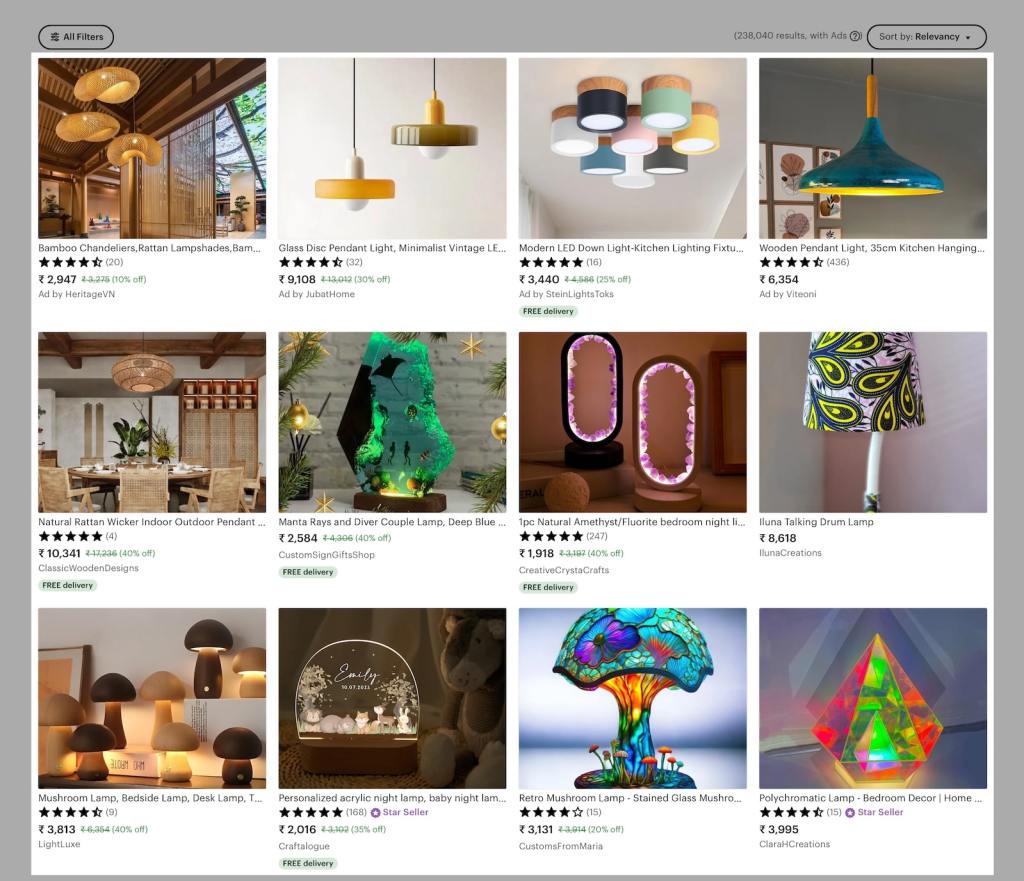
The platform has effective product photography ideas and examples from small-scale suppliers who have leveraged these resources to boost their sales.
Professional Product Photography vs DIY Product Photography
Regarding product photography, there are two primary routes that any Ecommerce business can consider — hiring professional product photographers or adopting a Do-It-Yourself (DIY) approach.
Investing in professional product photography has its merits. Professionals bring their expertise, equipment, and creative vision to create high-quality, eye-catching pictures that stand out. They know how and where to set up the shot for optimal lighting, what angles work well, and how to edit the photos to highlight the product’s best attributes. This can save you from technical pitfalls, ensure consistency, and afford you more time to focus on other aspects of your business.
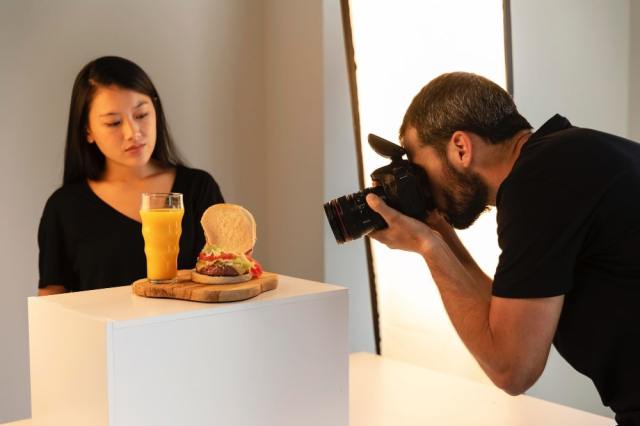
Also, professional photographers usually come with past experiences and market understanding, which can further add value to the overall output.
On the downside, professional product photography can be a hefty investment, especially for small businesses or startups with limited budgets. While it can prove rewarding in the long run, it may not be a viable option for all.
On the other hand, adopting the DIY approach to product photography bears its own set of advantages and disadvantages. The most apparent benefit is cost savings. You can take your product photos with a decent camera, some basic photography know-how, and photo editing software. You also have full control over the creative process, which can be rewarding.
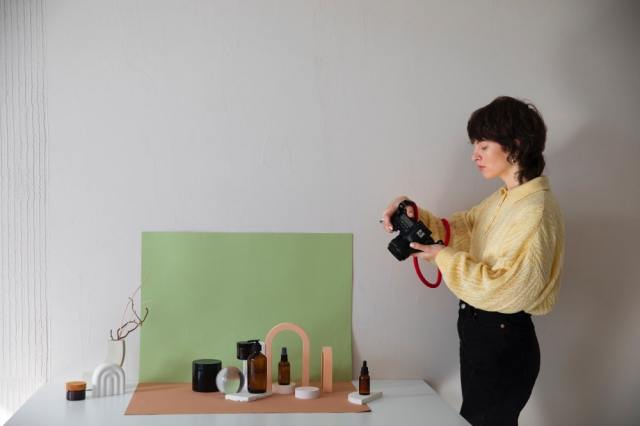
Plus, the flexibility of this method allows for quick changes and updates, which can be useful for adding new products to your own Ecommerce store or site.
However, the DIY route comes with its challenges. Achieving professional-quality photos requires time, patience, and a nuanced understanding of lighting, composition, and editing. There’s also the danger of inconsistency—if you’re unable to replicate your setup each time, your photos may lack a uniform look and feel, which is essential for brand recognition.
Step-by-Step Guide to DIY Product Photography
If you’re keen on giving DIY product photography a try, here’s a step-by-step guide to get you started:
Necessary equipments
Firstly, gather the necessary equipment. At a minimum, you will need:
- A good-quality camera: An entry-level DSLR or mirrorless camera is ideal, but even a top-tier smartphone camera can suffice.
- Lighting Equipment: Softbox or umbrella lighting kits are a great investment. Natural light can also work well if you master using it effectively.
- Backdrop: A seamless white paper or fabric backdrop is widely preferable.
- A tripod: This ensures stability and consistent framing.
- Editing Software: There’s a range of software available, from professional-grade Adobe Photoshop to simpler, less expensive options like Lightroom or even free options like GIMP.
Basic steps of taking attractive product photos
Now follow the steps to take amazing product pictures:
- Set up your backdrop and place your product on it.
- Set up your lighting to illuminate the product and minimize shadows.
- Position your camera on the tripod and ensure the product is in focus.
- Experiment with different angles and distances to find what best showcases your product.
- Take multiple shots to have various options.
Simple editing techniques to enhance product photos
Post-processing is crucial to polish your product photos. Using your chosen editing software:
- Adjust the brightness and contrast to ensure the product can be seen.
- Check color accuracy and adjust as necessary.
- Clean up any dust or minor imperfections on the product or backdrop.
Tips and tricks for successful DIY product photography
Here are a few tips you can follow to make your product photographs amazing:
- Keep your set-up simple: This ensures that the focus remains on the product.
- Consistency is key: Keep your lighting and setup consistent for a uniform look across all products.
- Learn and experiment: Watch tutorials, read articles, and continually strive to improve your skills.
- Patience and practice: Don’t worry if you don’t get the perfect shot initially. Practice makes perfect in product photography.
- Use a Tripod: This reduces camera shake and ensures sharp, well-composed images. It also allows for consistency in your shots.
- Leverage Natural Light: If you don’t have a professional lighting setup, natural light can be your best friend. Just be mindful of the time of day and its effect on the light’s quality.
- Use a High-quality Camera: Smartphone cameras are steadily improving, but a dedicated DSLR or mirrorless camera could provide more control over settings and significantly better image quality.
- Use Light Reflectors: Reflectors can help balance your lighting by bouncing light onto the dark side of your product. A piece of white cardboard or even aluminum foil can work if you don’t have a professional reflector.
- Use a White Background: Product photography is a standard because it doesn’t distract from the product. There are many affordable lightbox kits available online.
- Edit Your Photos: Post-processing can significantly enhance your images. Learn to use easy editing tools like Snapseed or Lightroom to adjust exposure, contrast, and clarity and remove any blemishes.
Remember, the ultimate goal of product photography, whether DIY or professional, is to accurately and attractively represent your product, leaving a lasting impression on potential customers.
Product Photography Tips
Great product photography can significantly upscale an eCommerce business’s growth trajectory.

Here are some tips to ensure the best product photographs:
- Use Proper Lighting: The importance of light in photography can’t be understated. Avoid using harsh direct light, which can create strong shadows and throw off the colors. Instead, you can use soft, diffused light to give your products a professional and appealing look.
- Pay Attention to Angles: Always experiment with shooting your product from various angles. This helps customers see the product from every perspective and comprehensively understand what they’re buying.
- Capture Detail: Close-up shots are an excellent way to bring attention to the product’s details and unique features. Ensure your images are crisp, and clear, and highlight the unique selling points of your product.
- Use a Neutral Background: A simple, neutral background will let your product stand out without any distractions. White is commonly used as it makes the editing process simpler.
- Consistency is Key: For brand uniformity, maintain consistency in the style and aesthetic of your product photos across the board.
Impact of Product Photography on Ecommerce Growth
High-quality product photography has a direct relationship with Ecommerce growth rates. Following the adage that a picture is worth a thousand words, high-quality photos and product photographs on an online platform can speak volumes about the product. It elevates the perceived value of the product and the brand, boosting customer trust and sales.
For instance, MDG Advertising found that product information accompanied by a quality image was retained 65% more by consumers after three days compared to only 10% retention when an image did not accompany the information.
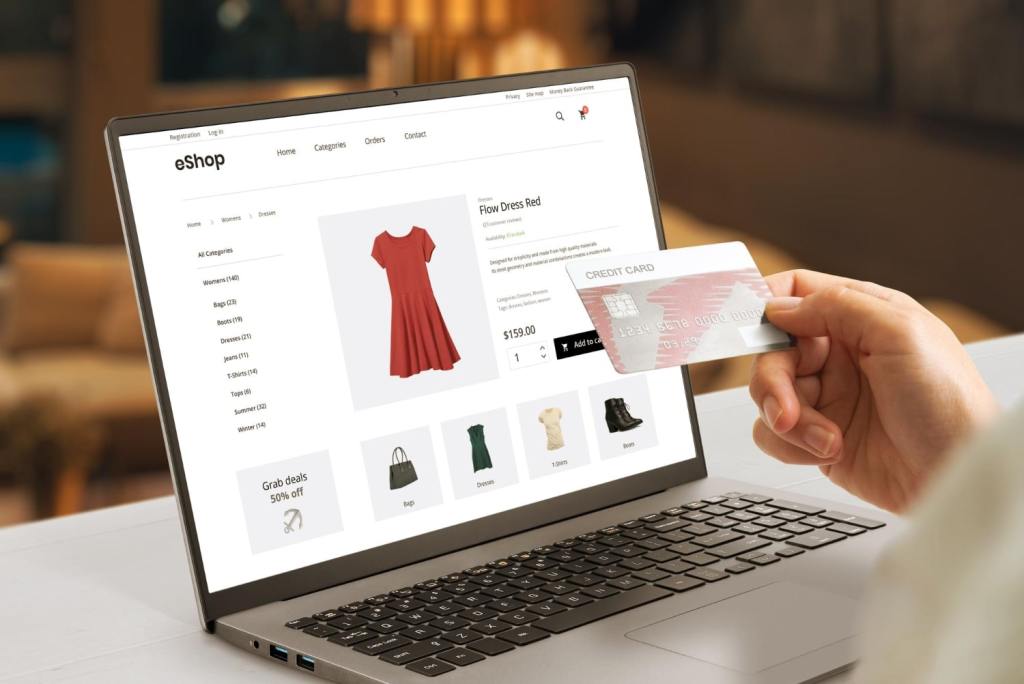
Online shoppers rely on images over descriptions or reviews in their purchasing decision-making process. A survey revealed that 75% of online shoppers rely on product photos when deciding on a potential purchase. These statistics underscore the profound effect of quality product photography on Ecommerce growth.
Future of Product Photography in Ecommerce
The future of product photography in Ecommerce will be augmented by technology advancements – 360-degree images, Virtual Reality (VR), Augmented Reality (AR), and 3D imaging are already making waves in the industry. These technologies provide an immersive shopping experience to customers by allowing them to visualize the product in a lifelike manner.
For instance, 360-degree product images allow customers to examine a product from all angles, making their online shopping experience closer to the physical retail experience. Similarly, AR helps users see how a product (like furniture, glasses, etc.) might look in their space, thereby enabling more confident purchase decisions.
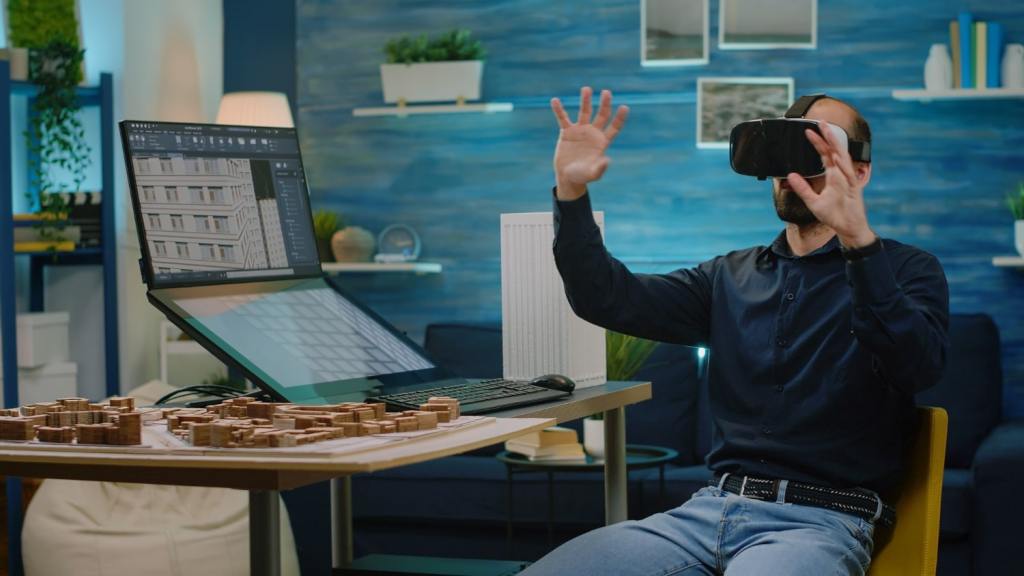
Integrating these technologies in product photography is expected to transform the Ecommerce industry, enhancing customer experience, reducing return rates, and boosting business growth.
Alongside these advancements, efficient shipping plays a crucial role in Ecommerce success. The availability of strategic tools like Advanced Flat Rate Shipping for WooCommerce ensures optimized, reliable, and fast shipping options strengthening the overall sales funnel.
Thus, future-proofing in Ecommerce goes beyond enhancing product photography. It is about leveraging technology advancements in product imaging, streamlining logistics and shipping, and continuously enhancing user experience to meet and exceed customer expectations.
Conclusion
In today’s digital age, product photography is pivotal in Ecommerce growth. It significantly influences consumer perception of your brand and products, boosting brand recognition and trust.
High-quality product photographs serve as a powerful communication tool that enables potential buyers to appreciate the features and benefits of your products, ultimately leading to increased sales and revenue.
Therefore, Ecommerce businesses must invest in quality product photography. Whether you hire a professional photographer or opt for a DIY approach, the goal remains to capture your product in the best possible light—to create a lasting positive impression that drives customer engagement and enhances business growth.
As technology advances, incorporate innovative technologies, like 360-degree imaging, AR, and VR, in your product photography strategy. This will future-proof your business by providing an immersive shopping experience to attract more customers.
For more such guides on growing e-commerce businesses and trips/tricks, visit our blog and follow us to get exclusive and latest updates regularly.
FAQs
What is product photography?
Product photography involves taking professional pictures of products to represent them accurately and attractively. These images are used on Ecommerce platforms, catalogs, and advertisements to entice potential customers and inform them about the product’s details, features, and benefits.
How do I start product photography?
To start product photography, gather your basic equipment (camera, lights, backdrop, tripod), set up your studio, and learn photography fundamentals. Practice taking various shots, edit them, and seek constructive feedback to improve.
Is product photography in demand?
Yes, product photography is in high demand, particularly in the Ecommerce industry. As more businesses move online, the need for high-quality product photos to represent brands and draw in customers has increased.
How much can you make doing product photography?
The income from product photography can vary widely based on factors like your skills, experience, location, and the size and scale of the project. On average, however, professional product photographers and photographers can earn between $30 to $500 per hour.
What makes good product photography?
Good product photography provides accurate and enticing images with clarity of details. It utilizes proper lighting, angles, sharp focus, and a clean, neutral background. Most importantly, it presents the product in a manner that it appeals to the target audience and prompts them to make a purchase.
How can I be creative in product photography?
To be creative in product photography, experiment with lighting, and camera settings, use props that complement the product, and try different angles. Incorporate lifestyle shots or a human element, and use color or post-processing to enhance the final image. Always prioritize accuracy and appeal while resonating with your target audience.


